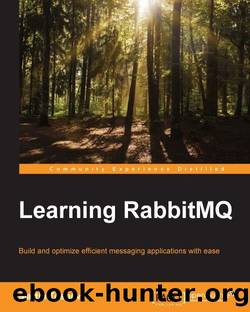Learning RabbitMQ by Martin Toshev

Author:Martin Toshev [Toshev, Martin]
Language: eng
Format: azw3
Publisher: Packt Publishing
Published: 2015-12-27T16:00:00+00:00
The locked attribute specifies that the parameters cannot be overridden by a WSO2 service. Add the following to configure the RabbitMQ transport sender in the axis2.xml configuration file:
<transportSender name="rabbitmq" class="org.apache.axis2.transport.rabbitmq.RabbitMQSender"/>
Apart from this, the ESB runtime may not need to load the RabbitMQ transport libraries (even though they have been installed from the p2 repository), and so you may need to copy them from the p2 repository to the <wso2_install_path>\repository\components\lib directory. As the libraries might be a little outdated with regard to the version of RabbitMQ that you are using, you can also download the source code of the WSO2 transports from GitHub, build the Maven project for the RabbitMQ transport, and replace the old version in the preceding directory. You need to make sure that the version of the transport library works with your version of the RabbitMQ broker.
After you have installed the RabbitMQ AMQP transport and added the configuration for the sender and receiver, restart the WSO2 server in order to load the new feature along with the configured transports.
Now, we are ready to configure a proxy service that will allow us to transfer messages from test-queue to test-destination-queue using the WSO2 ESB.
First, create an endpoint that will be used by the RabbitMQ transport sender by navigating to Main -> Endpoints -> Add Endpoint -> Address Endpoint:
Download
This site does not store any files on its server. We only index and link to content provided by other sites. Please contact the content providers to delete copyright contents if any and email us, we'll remove relevant links or contents immediately.
Algorithms of the Intelligent Web by Haralambos Marmanis;Dmitry Babenko(8518)
Test-Driven Development with Java by Alan Mellor(7347)
Data Augmentation with Python by Duc Haba(7249)
Principles of Data Fabric by Sonia Mezzetta(6993)
Learn Blender Simulations the Right Way by Stephen Pearson(6927)
Microservices with Spring Boot 3 and Spring Cloud by Magnus Larsson(6760)
RPA Solution Architect's Handbook by Sachin Sahgal(6165)
Hadoop in Practice by Alex Holmes(6028)
Jquery UI in Action : Master the concepts Of Jquery UI: A Step By Step Approach by ANMOL GOYAL(5869)
The Infinite Retina by Robert Scoble Irena Cronin(5866)
Big Data Analysis with Python by Ivan Marin(5692)
Life 3.0: Being Human in the Age of Artificial Intelligence by Tegmark Max(5397)
Pretrain Vision and Large Language Models in Python by Emily Webber(4651)
Infrastructure as Code for Beginners by Russ McKendrick(4435)
WordPress Plugin Development Cookbook by Yannick Lefebvre(4166)
Functional Programming in JavaScript by Mantyla Dan(4121)
The Age of Surveillance Capitalism by Shoshana Zuboff(4111)
Embracing Microservices Design by Ovais Mehboob Ahmed Khan Nabil Siddiqui and Timothy Oleson(3956)
Applied Machine Learning for Healthcare and Life Sciences Using AWS by Ujjwal Ratan(3928)
